Photos By Jorge Tequila

All-Wheel Drive Explained
An all-wheel-drive motorcycle is a bit on a unicorn. Unless you are Steve Christini and you have been making them for nearly 20 years now. Starting with kit conversions for Honda and KTMs, in 2002 he began producing his own motorcycle in two and four stroke versions in a collaboration with an Asian motorcycle manufacturing company and with Gas Gas for the two-stroke engines. In its third iteration the current 450AWD may be the bike you’ve been looking for–and even if not–you are curious. Here is why.
Adding drive to the front of a motorcycle is not a simple thing to do. Or at least do it correctly, which is why much of the Christini system is protected by patents that make it difficult if not downright impossible to copy. Transferring power through a steering stem and not having a significant amount of torque steer is the trick Christini mastered.

For 2020 Christini has an all-new engine management system with a much faster processor collecting more data from the engine to properly calibrate the fuel mapping within the ECU. The AWD resembles the former generation Honda CRF450X so much so that there are a lot of parts that will swap right over. But serious modifications were necessary to the aluminum frame to allow the addition of the all-wheel drive system. This, where a second chain is spun from the countershaft sprocket running to a clutch and transferring the power to a drive shaft that terminates inside the headset of the motorcycle. Power is then transferred through the steering stem center to counter-rotating drive shafts via a set of chains housed inside the lower tripleclamp. These shafts engage one-way gears on the front wheel to finally drive the front wheel at a speed of 68% of the rear wheel.
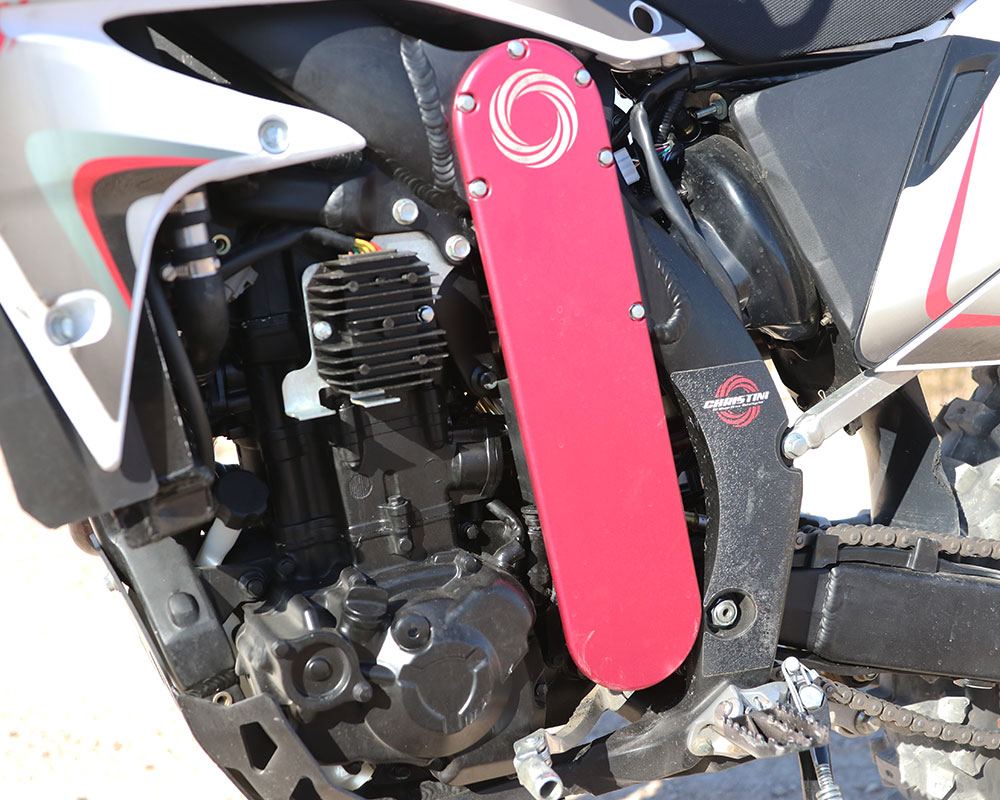
So, what does a two-wheel drive motorcycle do and do we really need this technology? The funny thing is, and I have a ton of time on these bikes, that it isn’t what you would really expect. The expectation and assumption is you’ll climb hills better and be able to drift turns with steering input does not really shine through. But the traits that really stand out are the instant get-up-and-go from a standing stop, especially in low traction situations and how the system seems to work more like a traction control system that really works compared to electronic ones that cut power. Due to the traction coefficient and the fact that the weight load of the bike is constantly changing when the bike is working the ground, the front wheel’s ability to pull the motorcycle along instantaneously and help distribute the power rather than having the power cut when the rear wheel spins (also when you may really need power) really makes sense. Yet most of the time when you are just riding along you may not even know or feel that AWD system working.
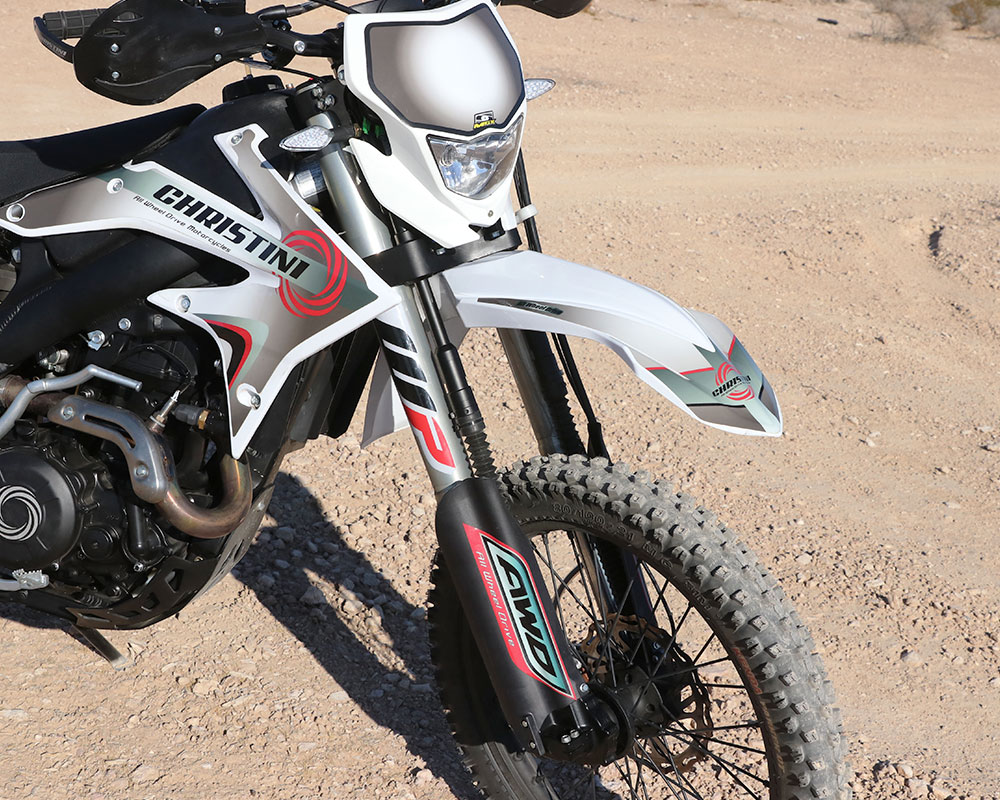
There are some advantages and disadvantages to anything like this and we’ll get to the negative first. The improved hill climbing misconception may be the biggest of these and for a very simple reason. Motorcycles usually spin on steep climbs and here the front wheel is light, so it will want to be driving (pulling). If you steer it out of line it will pull you off line. Higher level riders have to be much more aware of their balance and not correcting with out of direction steering inputs. Novice riders seem to not know any better and just react more in line with the Christini instead of having to break bad habits. As for sliding turns and steering into the turn, our experience is that the front wheel drive ratio is not high enough standard to allow enough wheel speed nor is enough power allowed to be transferred to the front to make this effective on the dirt. Yet some tests have been done with on-road and super moto applications where the system was heavily praised for this ability. There is definitely some torque feel that can be noticed through the steering but it takes a pretty aggressive and quick change in steering direction with an actively spinning rear wheel to notice it. For the most part this torque steer was acting as an advantage like a steering stabilizer as opposed to a hindrance in getting the bars to turn where a rider would like.
The system has been criticized for adding complexity and weight to a motorcycle, which it does. But even though complex, in our many hours with different bikes we have had minimal issues with the AWD specific parts aside from the newer lighter duty handlebar mounted switch being finicky. The weight, about 305 pounds full of gas, is a necessary evil. And about the only thing from an ergonomics perspective is the left side of the frame has a slight bulge where your inner leg rests when sitting or where your knees may pass when standing, depending on the size of the rider.
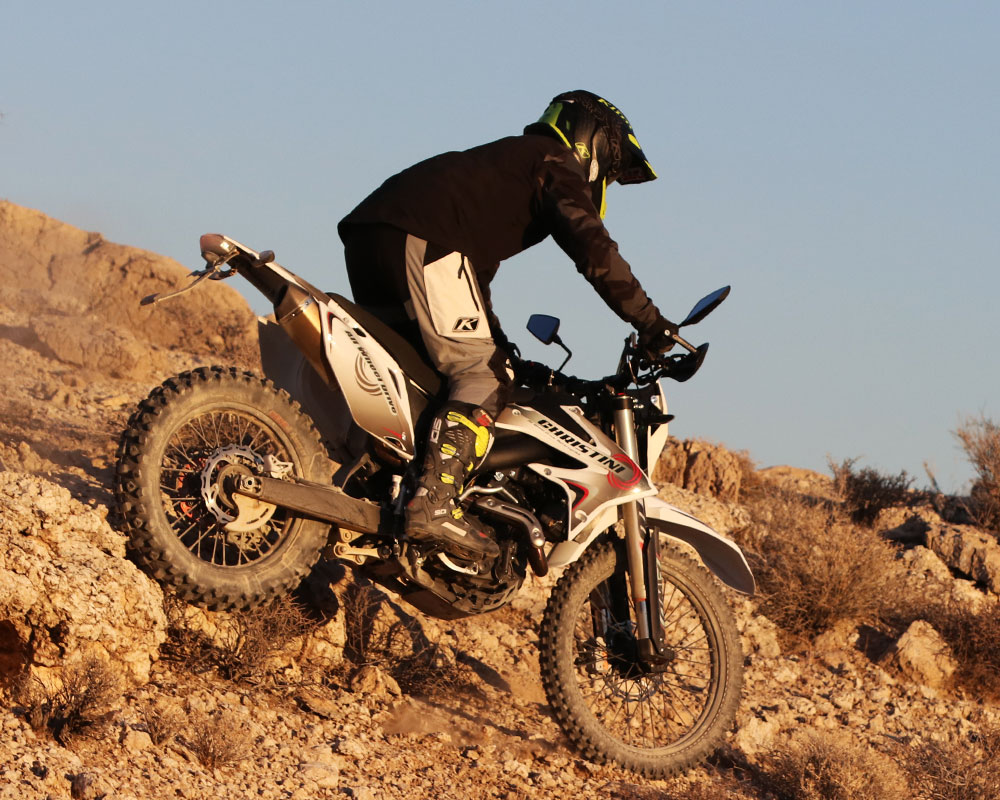
Where the Christini really shines is in low traction of any kind. Whether sand, mud or snow, the bike gets up and goes right away. It wants to go forward (or whatever direction the bars are turned) as soon as power hits the ground instead of digging in a little bit before going forward. When in motion in low traction, any time a rider comes back on the power that same initial bite or burst of traction is evident compared to a regular bike. This is really apparent on gravel which typically has the front end deflecting. In off-camber areas the rear end is less prone to continue to slide downhill as the front will actually help the bike track back in line when the rear slips. And when turning the bike in an upright (not leaned) angle like in tight trees, as soon as the front wheel gets through and is turned, a rider can use the power to pivot the bike and not push the front end. When going through V-ditches the pull of a weighted front as opposed to the light rear wheel is an advantage in getting a drive out of the ditch, not into it.
Some other characteristics of the system are a built in steering-stabilizer characteristic since the front end is technically pulling its own way forward as opposed to being pushed. We have found (and is seems the military too) that novice riders can really benefit from the ability of the front wheel to pull the rider back into balance when things start to go wrong since there are two tires trying to grab traction. A lot of time riders fall onto the front end and unweight the rear when bad things happen. And since balance is more difficult at lower speeds, the ability of the bike to get some speed quickly from a stop helps as well.
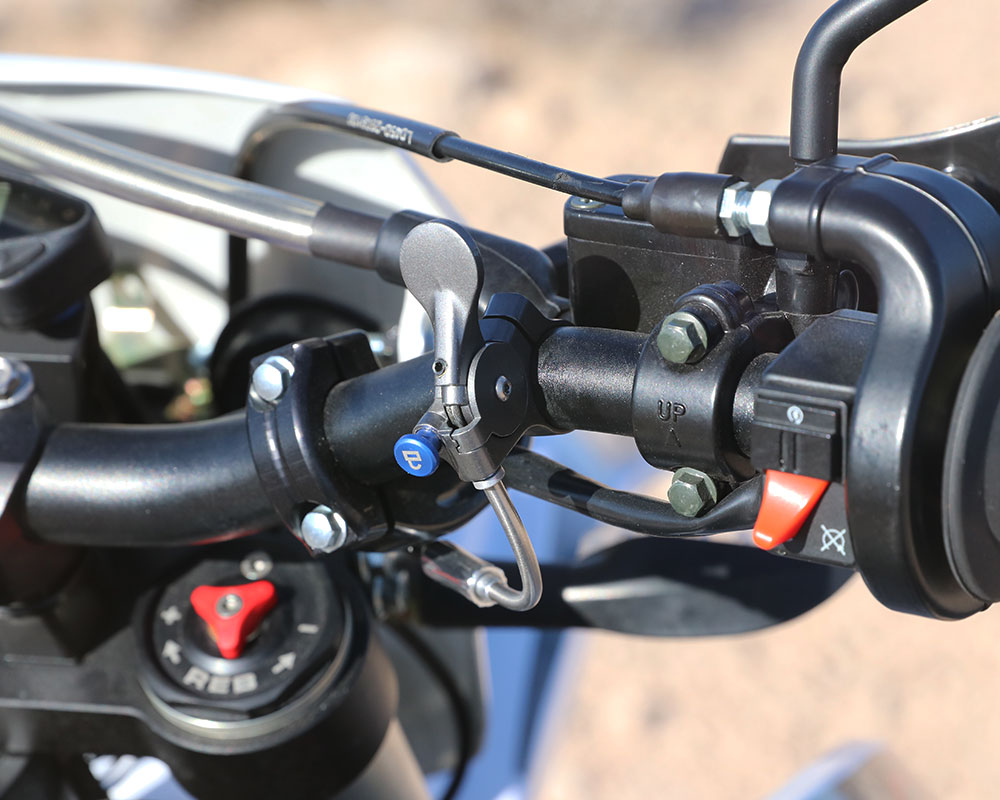
Now that we’ve explained the AWD advantages and disadvantages, here’s how this specific bike works. It is sold as a street-legal dual purpose machine. So it is technically corked up (quiet muffler and catalyst equipped) with a leaner ECU setting. We noticed the mostly Asia Wing built bike (China) will not have the fit and finish of a Honda or a KTM. With parts made in Taiwan, Austria, Indiana and in finally assembled in Philadelphia, PA. Though the quality has improved quite a bit in the last few years, there is some bracketry and hardware that seemed second class. And the wiring harness and loom could be sanitized quite a bit. We’d suggest an owner give all this a once-over and make sure wires are not touching things they shouldn’t or getting pinched. But overall the new black frame and motor look sharp and the bike has a decent look with some parts that are very sano and well built. The wheels impressed us. The AWD system is very robust and tight.
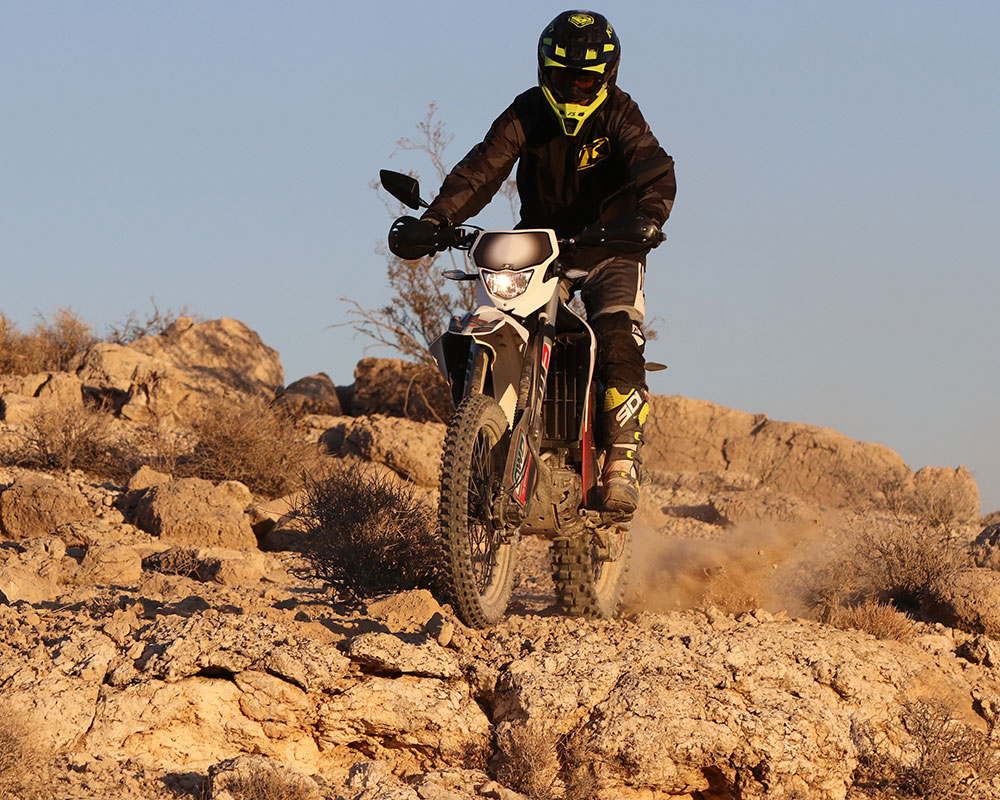
The 450cc motor fires right up and has a stepper motor to bump the idle up when cold or for a re-start. Throttle response is not a quick and instant as most current FI bikes but it is worlds better that the previous generation of Christini that felt like it had a one-second delay between the turn of the throttle and the response of the motor. More of a classic thumper in style the power pulses can be felt and the motor chugs out power rather than blurs the power together with revs. Off of idle the is plenty of torque and it builds progressively without steps in the power delivery all the way through the rev range. It is not a race-style motor by any means but it is just what a trail rider is looking for. Considering the use of this bike we’d say the power is perfect for the application and is always plentiful. The FI mapping is spot on and handled elevation and temperature changes as good as any system. There was the random low RPM stall for no apparent reason, like a hiccup, but not often enough for us to call it an issue, but we were over-testing the torque of the motor when it would happen. There is a cooling fan on the radiator and we had it running in our tougher trails yet the bike never lost coolant. It also has a recovery tank which must be working.
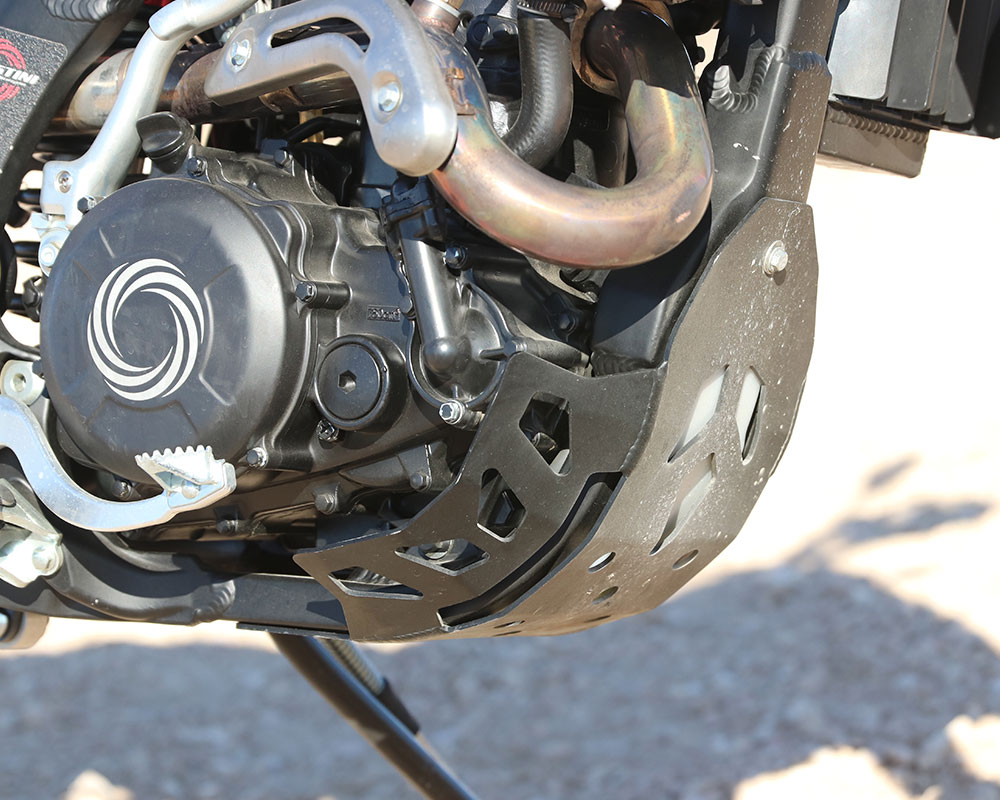
Since it builds revs slowly each gear in the five speed box lasts a long time with more of a close ratio profile to the gearbox. First is just a tad tall and fifth is not tall enough in our opinion. In a spread like this we’d like to have a sixth speed. The clutch pull is very light and it seemed to take abuse quite well. In fact we’d say Christini performs better than even the Honda engne it looks so much like in this department. Shifting gets better as the bike breaks in and after the first oil change too. The brakes are not the strongest and lack the feel of the top of the line bikes we are typically on. But they slow the bike just fine. And when in AWD the front actually has a built-in anti-lock of sorts due to the drive.
Onto the handling of the bike and you can feel the weight of the 300-pound bike. But it isn’t as bad as the scale makes it sound and more of a characteristic of the AWD feeling in the handlebar when things get testy and learning to use the advantages of the bike and not fighting them. Which was very dependant on the skill level of the rider, we have noticed. Most novice riders never commented on the weight unless picking up the bike. Riders of higher level that were not open to the different characteristics always said the bike felt heavy (as they fought the bike) and riders that appreciated the advantages said the bike acts lighter than they thought it would be.
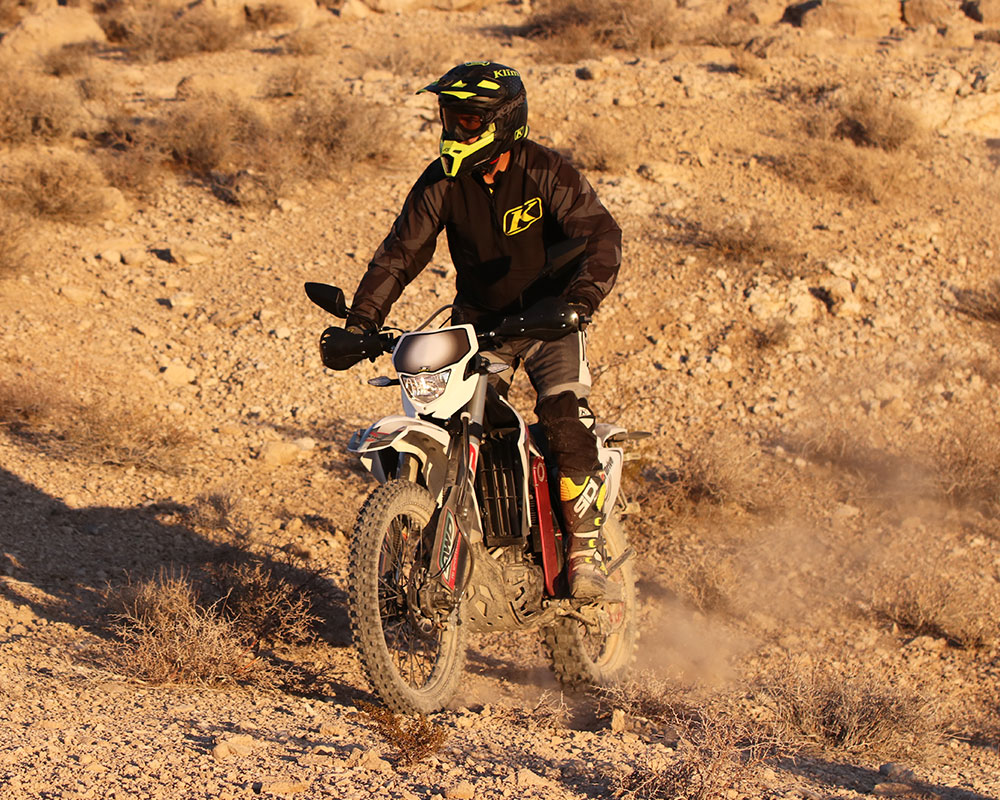
The Christini has a balanced chassis with suspension set on the softer side of the setup, especially in times when everything is getting stiffer. The WP XPLOR front fork is of the same pedigree as the current KTM EXC bikes and it is supple and uses the stroke well. The Fast Ace rear shock is valved to match with a softer and very plush feel. It too uses the stroke to take the harshness out of the ground and together they give the ride a planted and connected feel for the ground. Yet both could ends could use some improved bottoming resistance for faster speeds or more aggressive level riding if that is in the cards. No racing speeds, this isn’t an issue. As we put more time on the bike we may test one of the accessory Elka shocks that come on the two-stroke Christini to see if that gives the bike more wings.
Right from the get-go the Christini has a longer feel with the front end a bit raked out. Especially if the AWD is turned off. This adds stability to the handling character and the turning is sluggish. But as soon as you engage the AWD this character goes away and the bike turns predictably and easily. The stability is still there but the front end becomes more active. Since it will compress into the turn with softer suspension and technically pull its way through the turns the bike works really good here as long as the rider does not fight the bars in the turns. When
bouncing in rougher terrain the active pull of the front seems to really help the suspension not slam into things so the softer setup is not as detrimental as it could be with the AWD off. Then as we explained earlier, the instant jump the Christini gets either from a stop or when the throttle is twisted is an advantage every time you get on the gas and more and more as a rider learns to gas it out of tough situations and trust the extra traction. It is traction control that works.
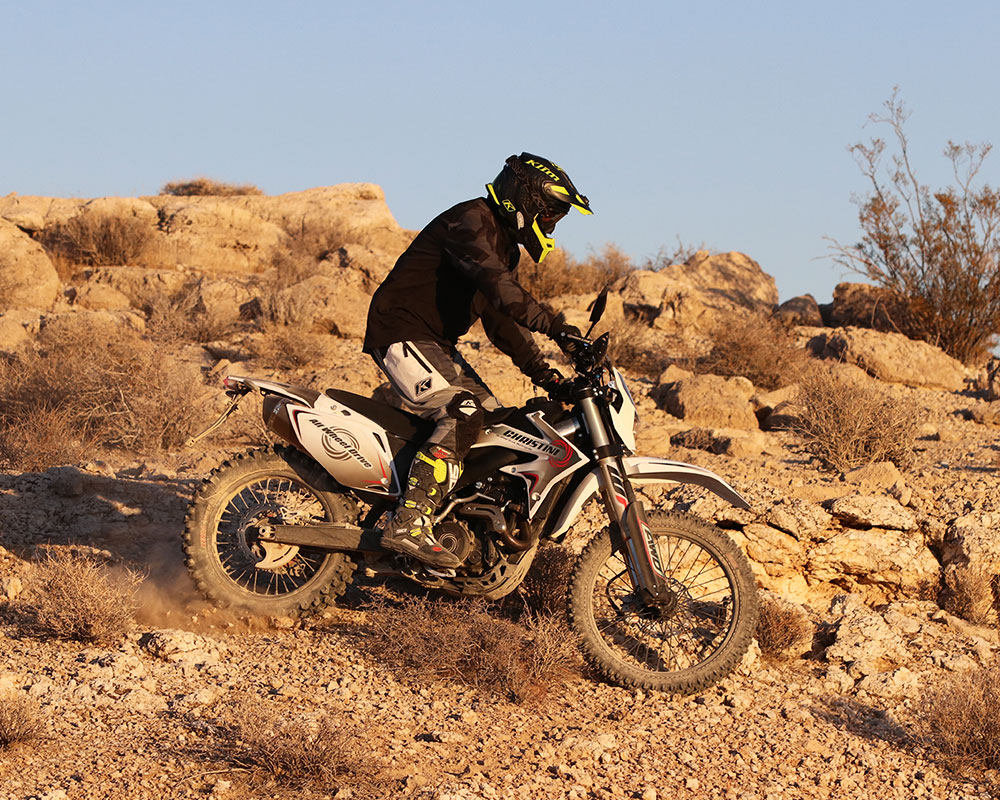
Overall the Christini 450AWD is a platform that is unique and we feel surprisingly under utilized. We’ve been lucky enough to test it on a heavy adventure bike and it is game changing. But for a trail rider or a novice ride looking for something to make technical riding a little bit easier, aside from the weight, this bike is a viable choice. Using a competent and familiar platform and upping the game with fuel injection the Christini is staying current and in a price range that is a deal considering the unique AWD. We’ll be putting more time on the bike, looking into performance modifications and durability and keep you updated on the progress.
Support DBT, Shop and search for products through the link below:

